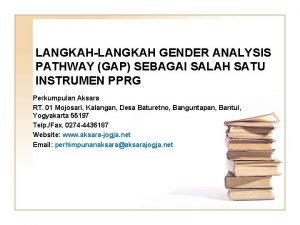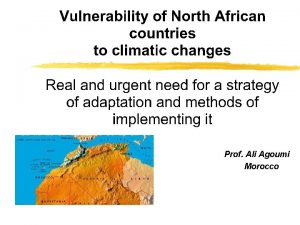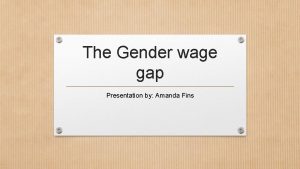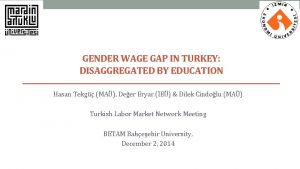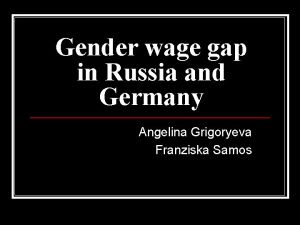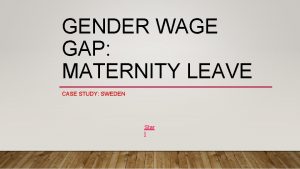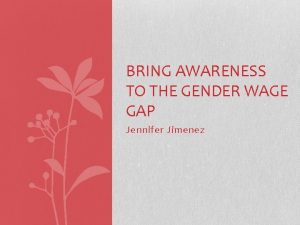Gender Wage Gap in Morocco What can statistics





















- Slides: 21

Gender Wage Gap in Morocco: What can statistics tell us? Mustapha Ziroili Jamal Guennouni

OUTLINE 1. Introduction & Context 2. Gender & labor market in Morocco: an overview 3. Gender wage gap: literature revew & measures 4. Data & Empirical results 5. Conclusions

INTRODUCTION & CONTEXT Conceptuel Framework From capability approach …. …to SDGs Goal 5: Achieve gender equality and empower all women and girls Understanding the roots of inequalities between the women and reducing gender gaps have a central place in terms of policies Human development for everyone Source: HDR 2016

INTRODUCTION & CONTEXT • In Morocco. over the past years. women have benefited from several institutional and social reforms guaranteeing wider rights and favoring their emancipation and their contribution to national development. The result of these reforms was a larger participation of women in the politic. economic and social arenas. • However. their participation in the labor market has not improved; it has even declined in recent years and even she is in labor market she suffers from a penalty and discrimination. • In spite of its structural feature in Morocco. little is known about the magnitude of the this phenomena. And this paper comes to participate to national debate on this phenomena

d ite ab Ar Em ira 50 45 40 35 30 25 20 15 10 5 0 Sa te s Om ud an i. A ra bi a Qa ta Jo r rd an A W lge es r t. B B ia an ah r k Eg an ain yp d G t, Ar aza ab R Le ep. ba no n S Ye ud m a en n , R M ep. or oc c Tu o ni si Ku a M wa au it rit an i Tu a Eu rk ro ey pe OE & CD Chi Ce m na em n b Su tral b- As ers Sa ia ha (e ra x. . Un n A. fr Eu ited ica ro S pe tat an es Un io Ca n na De da nm ar k Un GENDER & LABOR MARKET IN MOROCCO: AN OVERVIEW Female labor force participation (%). 2016 44 Source : World Development Indicators 46 47 26 12

GENDER & LABOR MARKET IN MOROCCO : AN OVERVIEW Labor market participation by age and level of diploma: Women The probability of being economically active (in labor market) increases with level of diploma Men Graduate men are less likely to be active than men with no -diploma.

GENDER & LABOR MARKET IN MOROCCO : AN OVERVIEW A woman with a higher education diploma is 16 times more likely to participate in the labor market than a woman without a diploma. This is due to the fact that women who continue their education or training declare themselves to be active and available for work. unlike women without a diploma who are generally engaged in domestic activities and declare themselves to be housewives. For men. the situation is quite different where the probability of being active for a man without a diploma is greater than the probability of being active for a man with a diploma of any level. This can be explained by the preponderance of low-skill jobs which are usually occupied by men without a diploma (breadwinner).

GENDER & LABOR MARKET IN MOROCCO : AN OVERVIEW Probaility of working in a decent wage-work, indecent wage-work, self-employed or unpaid work in comparison to not work – Urban Women+15 years old Variables Decent wage-worker Indecent wage-worker Self-employed Unpaid employment Level of diploma (reference modality is “without diploma”) Primary Secondary Higher diploma Vocational training 1. 4421*** -0. 4650*** 0. 0364 4. 22 0. 62 1. 03 -0. 5745*** 0. 56 2. 3868*** -1. 0252*** -0. 0627 -1. 3689*** 10. 22 0. 35 0. 93 0. 25 4. 0088*** -0. 3218*** 1. 1044*** -0. 026 55. 08 0. 75 3. 01 0. 97 2. 4641*** 0. 4782*** 1. 9603*** -0. 2337 11. 75 1. 61 7. 1 0. 79 • The higher the level of the diploma. the greater the probability of obtaining a decent wage-work; • Women with a vocational training diploma are more likely to work as self-employed; • Unqualified women are more likely to work as unpaid worker (contributory family).

GENDER & LABOR MARKET IN MOROCCO : AN OVERVIEW Probaility of working in a decent wage-work, indecent wage-work, self-employed or unpaid work in comparison to not work – Urban Men +15 years old Decent wage-worker Variables Indecent wage-worker Self-employed Unpaid employment -0. 8053*** -0. 8826*** Level of diploma (reference modality is “without diploma”) 0. 1853*** Primary Secondary Higher diploma Vocational training -1. 1797*** 1. 2 0. 3 0. 44 0. 41 0. 4328*** -2. 7504*** -1. 6839*** -2. 4229*** 1. 54 0. 06 0. 18 0. 08 1. 6077*** -2. 5887*** -1. 2805*** -1. 5069*** 4. 99 0. 07 0. 22 1. 0973*** -1. 4655*** -1. 0751*** -1. 4387*** 2. 99 0. 23 0. 34 0. 23 • The more qualified men are more likely to be employed in a decent job than to remain unemployed or out of labor market; • Men without a diploma are more easily to get a job as one of the other 3 status (indecent wage-work, self-employed or unpaid worker) than the graduates men.

GENDER & LABOR MARKET IN MOROCCO : AN OVERVIEW For the urban woman. Education is the key to entering the labor market. For the man. The latter does not constitute a serious issue. This is mainly explained by the widespread of informal and low-skill jobs. Investing more in education, in mechanisms of matching between education/training and employment and improvement of the economic structure for more decent jobs (formalizing of the informal economy).

GENDER WAGE GAP: LITERATURE REVEW & MEASURES o The literature on the economics of discrimination started with Becker’s seminal study ; o Since then, a number of authors have calculated gender wage gap at equal productivity (due to the proliferation of the use of microdata in the last three decades)

GENDER WAGE GAP: LITERATURE REVEW & MEASURES The most comon way to analyze discriminqtion based on gender is to compare male and female earnings holding productivity constant: Include a sex (1 is woman and 0 if not) dummy in the wage resgression model: One of the techniques widely used is the decomosition technique as pioneered by Blinder & Oaxaca (1973).

GENDER WAGE GAP: LITERATURE REVEW & MEASURES Two methodological issues have to be dealt with: o First, male and female wage equations have to be estimated consistently. Proper treatment of various methodological problems such: sample selection biases in the estimation. The often-recommended estimation strategy is the use of Heckman’s two step procedure; Heterogeneitybiased estimates; and Endogeneity.

GENDER WAGE GAP: LITERATURE REVEW & MEASURES o The second methodological issue concerns the appropriate decomposition of the gender wage gap that allows meaningful interpretation of its components. The literature has proposed different weighting schemes to deal with the underlying index problem: ü Oaxaca (1973) proposes either the current male wage structure or the current female wage structure as the “true” non-discriminatory wage structure; ü Reimers (1983) implements a methodology that is equivalent to assigning identical weights to men and women. ü Cotton (1988) argues that the non-discriminatory structure should approach the structure that holds for the larger group and use as a weighting structure the fraction of males in the sample

GENDER WAGE GAP: LITERATURE REVEW & MEASURES ü Neumark (1988) proposes a general decomposition of the gender wage differential such as: • Neumark shows that β* can be estimated using the pooled sample to estimate β*. • The first term is the gender wage gap attributable to differences in characteristics. • The second and the third terms capture the difference between the actual and pooled returns for men and women, respectively.

DATA & EMPIRICAL RESULTS This analysis is focused on investigating gender wage differentials among wage workers (who work for salary). The sample in the analysis is restricted to men and women between 15 and 64 years old and who have permanent and full time job in urban area. Wages are defined in terms of monthly wage income from main employement, expressed in Moroccan Dirham. Source of data: Moroccan Labor Force Survey (2012): • Sample size: 60000 households (≈250000 individuals) • A quarterly and continious survey since 1999 • Scope of survey: urban and rural area

DATA & EMPIRICAL RESULTS Variables for wage equations: › Level of education (5 dummies) › Potential experience and its square (continous) › Marital Status (3 dummies) › Contract (2 dummies) › Regions (15 dummies) › Industry (2 dummies) › Head of HH or not Variables for probit equations (for Heckman’s correction): › + child 06_sum › + child 717_sum

DATA & EMPIRICAL RESULTS Neumark’s Decompositions (at the mean):

DATA & EMPIRICAL RESULTS Machado-Mata decomposition (J Applied Edonometrics): Going beyond the Mean The methodology of the decomposition is as follows: 1. Estimate the coefficients βm and βf using the male data set and the female data set, respectively. 2. Randomly draw 1, 000 women (with replacement) and use their characteristics to predict wages using the estimated coefficients βm and βf. 3. Generate two sets of predicted wages covering the whole distribution. 4. Calculate the marginal distribution of women’s wages and the marginal distribution of men’s wages that would obtain if their characteristics were distributed as women’s are. 5. Using these distributions, estimate the wage gap as the difference between the predicted wage at each quantile using the newly generated wage distribution for women and the counterfactual distribution for men.

DATA & EMPIRICAL RESULTS Machado-Mata decomposition (at Quintile level):

CONCLUSIONS The gender wage gap in Moroccan labor market arises because of unequal treatment against women rather than differences in their human capital characteristics; Continous labor force surveys allows us, from a supply side, to monitor this phenomenon of discrimination against women and guide the political decisions to deal with it and achieve one of the sustainable development indicators; But, the national system of statistics should conduct more entreprise surveys to undertand the root of discrimination from the demand side.
 Strategic gender needs and practical gender needs
Strategic gender needs and practical gender needs Hospitality market in morocco
Hospitality market in morocco Morocco meteorological service
Morocco meteorological service Bir-jdid prison
Bir-jdid prison Ministry of education morocco
Ministry of education morocco Investment opportunities in morocco
Investment opportunities in morocco Morocco
Morocco Moroccos
Moroccos Pfitzner e kawaguchi
Pfitzner e kawaguchi French grading system conversion
French grading system conversion Tropic seamount morocco
Tropic seamount morocco Slidetodoc.com
Slidetodoc.com Gender
Gender Contoh gender analysis pathway (gap)
Contoh gender analysis pathway (gap) Centre for gender diversity and inclusion statistics
Centre for gender diversity and inclusion statistics Centre for gender diversity and inclusion statistics
Centre for gender diversity and inclusion statistics Bog'langan qo'shma gaplar referat
Bog'langan qo'shma gaplar referat A_______ bridges the specification gap between two pls.
A_______ bridges the specification gap between two pls. Introduction to statistics what is statistics
Introduction to statistics what is statistics Hattrick wage calculator
Hattrick wage calculator What is a wage
What is a wage What is a wage
What is a wage













